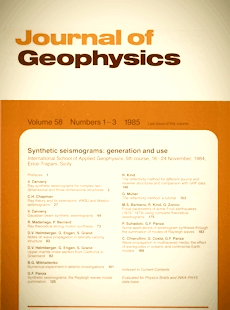Wave propagation in multilayered media: the effect of waveguides in oceanic and continental Earth models
Article Sidebar

Vols. 1-18 (1924-1944), ISSN 0044-2801
Main Article Content
Abstract
We investigate the effect of low-velocity waveguides on ground motion. The computation of eigenvalues and eigenfunctions of Rayleigh waves up to the frequency 10.0 Hz allows an analysis of the seismic response which is source independent. The main conclusions of this study are: (1) Extending the model to depths greater than that of the waveguides allows the exact computation of leaking modes. (2) A source in a layered structure generates P waves of higher frequency than S waves even if the structure is purely elastic. (3) At high frequencies (10.0 Hz) the modal components of P waves separate from those of SV waves. (4) Strong surface waves are generated by shallow sources in sedimentary basins, also at a source distance of a few tens of kilometres. These waves do not appear in structures without sediments. (5) The polarization of strong ground motion at the surface of low-velocity layers is mainly horizontal. (6) For oceanic models, the contribution of the sedimentary layers is separable from that of the water layer only at high frequencies.
 ARK: https://n2t.net/ark:/88439/y014925
ARK: https://n2t.net/ark:/88439/y014925
Permalink: https://geophysicsjournal.com/article/294
Article Details
References
Biswas, N.N., Knopoff, L. (1974) The structure of the upper mantle under the United States from the dispersion of Rayleigh waves. Geophys. J. R. Astron. Soc. 36:515-539
Brady, A.G., Perez, V., Mork, P.N. (1980) The Imperial Valley earthquake, October 15, 1979, digitization and processing of accelerograph records. U.S. Geol. Surv., Open-File Rept. 80-703, 309 pp.
Deresiewicz, H., Mindlin, R.D. (1985) Axially symmetric flexural vibrations of a circular disk. J. Appl. Mech. 22:86-88
Ebeniro, J., Wilson, C.R., Dorman, J. (1983) Propagation of dispersed compressional and Rayleigh waves on the Texas coastal plain. Geophysics 48:27-35
Fuis, G.S., Mooney, W.D., Healey, J.H., McMechan, G.A., Lutter, W.S. (1982) Crustal structure of the Imperial Valley region. U.S. Geol. Surv. Prof. Paper 1254:25-49
Harkrider, D.G. (1970) Surface waves in multilayered elastic media. Part II. Higher mode spectra and spectral ratios from point sources in plane layered elastic models. Bull. Seismol. Soc. Am. 60:1937-1987
Hartzell, S.H., Brune, J.N., Prince, J. (1978) The October 6, 1974 Acapulco earthquake: an example of the importance of short period surface waves in strong ground motion. Bull. Seismol. Soc. Am. 68:1663-1677
Johnson, L.R., Silva, W. (1981) The effects of unconsolidated sediments upon the ground motion during local earthquakes. Bull. Seismol. Soc. Am. 71:127-142
Kovach, R.L., Anderson, D.L. (1964) Higher mode surface waves and their bearing on the structure of the Earth's mantle. Bull. Seismol. Soc. Am. 54:161-182
McMechan, G.A., Yedlin, M.J. (1981) Analysis of dispersive waves by wave field transformation. Geophysics 46:869-874
Mooney, H.M., Bolt, B.A. (1966) Dispersive characteristics of the first three Rayleigh modes for a single surface layer. Bull. Seismol. Soc. Am. 56:43-67
Panza, G.F. (1985) Synthetic seismograms: the Rayleigh waves modal summation. J. Geophys.
Panza, G.F., Schwab, F., Knopoff, L. (1972) Channel and crustal Rayleigh waves. Geophys. J. R. Astron. Soc. 30:273-280
Phinney, R.A. (1961) Leaking modes in the crustal wave-guide. 1. The oceanic Pl wave. J. Geophys. Res. 66:1445-1469
Schwab, F., Knopoff, L. (1971) Surface waves on multilayered anelastic media. Bull. Seismol. Soc. Am. 61:893-912
Tatham, R.H. (1975) Surface-wave dispersion applied to the detection of sedimentary basins. Geophysics 40:40-55
Tolstoy, I. (1956) Resonant frequencies and high modes in layered wave guides. J. Acoust. Soc. Am. 28:1182-1192
Tolstoy, I., Usdin, E. (1957) Wave propagation in elastic plates: low and high mode dispersion. J. Acoust. Soc. Am. 29:37-42











